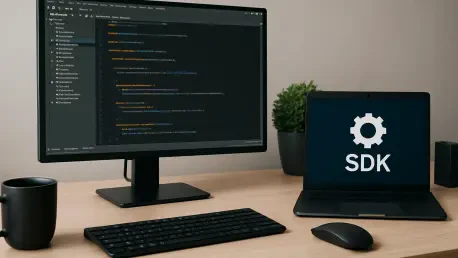In the ever-evolving world of geospatial application development, staying ahead of updates and managing software changes can often feel like navigating a complex maze without a map. For developers relying on the ArcGIS Maps SDK for JavaScript, a critical tool for building cutting-edge mapping solutions, a significant update is on the horizon that promises to simplify this journey. The transition to semantic versioning, commonly known as SemVer, marks a pivotal shift aimed at delivering greater clarity, predictability, and ease of integration. This change addresses long-standing challenges with unclear upgrade paths and unexpected breaking changes, offering a structured framework that could transform how developers interact with the SDK. As the industry moves toward standardized practices, this adoption signals a commitment to enhancing the developer experience, ensuring smoother updates, and fostering confidence in adopting new releases.
Decoding the Shift to Semantic Versioning
The move to semantic versioning introduces a logical and transparent system for the ArcGIS Maps SDK for JavaScript, utilizing the MAJOR.MINOR.PATCH format to communicate the nature of each release. A MAJOR version increase indicates significant changes or deprecations that may necessitate code adjustments, alerting developers to potential disruptions. In contrast, a MINOR update brings new features or minor deprecations while maintaining backward compatibility, allowing for safer implementation. Meanwhile, a PATCH release focuses solely on bug fixes or security enhancements without altering existing functionality. This structured approach stands in stark contrast to the previous versioning method, such as 4.33 or 4.33.12 on npm, where the impact of updates was often ambiguous, leaving developers guessing about potential risks. With SemVer, the version number itself becomes a quick reference, enabling instant assessment of whether an update can be seamlessly integrated or requires detailed review and planning.
Beyond the format, this versioning strategy fundamentally reshapes how developers approach SDK updates by providing a clear signal of change magnitude. Under the old system, even minor updates could harbor unexpected breaking changes, creating hesitation or costly rework. Now, with SemVer’s explicit categorization, the risk of silent disruptions diminishes significantly, as each release type telegraphs its intent. Developers can confidently apply patch updates for critical fixes without worrying about compatibility issues, while minor releases offer access to enhancements without upheaval. For major releases, the forewarning of potential incompatibilities ensures that adequate preparation, such as consulting migration guides, can be undertaken. This clarity not only streamlines decision-making but also aligns the SDK with widely accepted industry standards, fostering trust and reducing friction in the development process.
Advantages Driving the SemVer Adoption
The decision to embrace semantic versioning stems from a clear intent to elevate the developer experience by prioritizing transparency and minimizing upgrade risks. With version numbers acting as an immediate indicator of update impact, developers gain a powerful tool to navigate changes efficiently—major releases highlight the need for careful migration planning, while minor and patch updates assure compatibility with existing codebases. This predictability allows for better scheduling of updates, as significant disruptions are confined to major releases, and incremental improvements can be adopted without apprehension. Such a framework reduces the likelihood of unexpected issues derailing projects, offering a smoother path to integrating the latest features or fixes into geospatial applications.
Additionally, the alignment of SemVer with modern development tools amplifies its benefits for the ArcGIS Maps SDK community. Integration with dependency management systems like npm, Yarn, and automated update services such as Dependabot becomes more seamless, facilitating efficient workflows and continuous integration processes. This compatibility supports automated upgrades for minor and patch releases, cutting down on manual intervention and potential errors. The overarching aim is to lower the barriers to adoption, decrease integration costs, and ensure swift delivery of security updates without compromising stability. By addressing these critical pain points, the transition to SemVer positions the SDK as a more reliable and developer-friendly platform, paving the way for enhanced productivity and reduced support overhead in building sophisticated mapping solutions.
Mapping Out Release Cadence and Support Policies
A cornerstone of this versioning overhaul is the introduction of a well-defined release schedule for the ArcGIS Maps SDK for JavaScript, designed to aid developers in planning ahead. Starting in 2026, the team will roll out one major release each February, such as version 5.0, followed by two minor releases in June and October, like 5.1 and 5.2, with the subsequent major update to 6.0 planned for February 2027. This consistent rhythm provides a predictable timeline for anticipating significant changes and preparing for them, eliminating the uncertainty that often accompanies sporadic updates. By establishing such a cadence, developers can strategically align their project milestones with SDK releases, ensuring minimal disruption during critical development phases.
Complementing the release schedule is a revised support policy that underscores long-term stability and reliability. Each release remains in general availability until the next minor version is issued, with extended support spanning three years from the initial major release. Bug fixes and patches will be directed to the most recent minor version of a supported major release, maintaining a focus on current implementations. This policy also aligns with updates to ArcGIS Enterprise guidelines, ensuring coherence across platforms, while prior releases, including the forthcoming 4.34—the final in the 4.x series—remain unaffected by these changes. Such a structured support framework offers developers assurance that their applications will continue to receive necessary updates and maintenance, fostering confidence in adopting new versions without fear of being left unsupported prematurely.
Harmonizing with the ArcGIS Ecosystem
The transition to semantic versioning extends beyond the ArcGIS Maps SDK for JavaScript, reflecting a broader commitment to integration across the ArcGIS ecosystem, particularly with the Calcite Design System. Many developers leverage Calcite for crafting user interface elements in custom applications, relying on its synergy with the SDK for cohesive functionality. Historically, coordinated releases with ArcGIS Online have been essential to ensure that new features and improvements are uniformly accessible across platforms. With Calcite already adhering to SemVer principles, its major releases will now synchronize with those of the SDK, creating a streamlined update experience that minimizes discrepancies and compatibility challenges for integrated projects.
This ecosystem-wide alignment aims to reduce friction for developers working on multifaceted solutions that span multiple ArcGIS components. By ensuring that updates to the SDK, Calcite, and ArcGIS Online are released in tandem, the risk of mismatched versions disrupting workflows is significantly lowered. This coordinated approach not only enhances the consistency of the development environment but also simplifies the process of adopting new capabilities across the tech stack. As a result, developers can focus on innovation rather than troubleshooting integration issues, knowing that each platform update is designed to work harmoniously with others, ultimately leading to more robust and user-friendly geospatial applications.
Reflecting on a Developer-Centric Evolution
Looking back, the adoption of semantic versioning by the ArcGIS Maps SDK for JavaScript team represented a transformative step toward enhancing clarity and control for developers. This strategic shift addressed past frustrations with ambiguous versioning by implementing a clear MAJOR.MINOR.PATCH structure, ensuring that every update carried a predictable impact. The synchronized release schedules and extended support policies provided a stable foundation, while alignment with tools and ecosystem components like Calcite streamlined integration efforts. Moving forward, developers can leverage this framework to plan upgrades with confidence, explore migration guides for major changes, and stay updated with minor enhancements through automated tools. This evolution underscored a dedication to fostering a supportive environment, encouraging the community to build innovative geospatial solutions with reduced uncertainty and greater efficiency.









